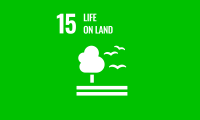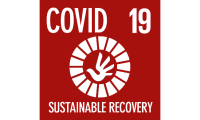SDG 15 and Sustainable Recovery

Key aspects of SDG 15:
1. Ensure the conservation, restoration and sustainable use of ecosystems, their services and the biodiversity within them (targets 15.1, 15.2, 15.4, 15.5, 15.9)
The transmission pathway of diseases such as COVID-19, from animals to humans, highlights the extent to which humans are placing pressures on the natural world with damaging consequences for all. The degradation of natural habitats and loss of biodiversity combined with illegal trade in species, and wet markets are creating pathways for future pathogen transmissions and thus zoonoses, making future pandemics increasingly likely.
The United Nations Environment Programme finds that 75% of all emerging infectious diseases in humans are zoonotic and that these zoonotic diseases are closely interlinked with the health of ecosystems.
The degradation of terrestrial and inland freshwater ecosystems and their services, in particular forests, wetlands, mountains and drylands, has impacts on all of humanity and an acute impact on the billions of people who directly depend on these resources for their livelihoods.
Some places have seen accelerated mining and resource extraction to fund response and recovery. This has been shown to increase pressure on indigenous land as well as on land and environmental defenders.
Sustainable recovery actions:
Recovery must involve transformational change to reverse the degradation of the earth’s ecosystems and the biodiversity within them. This requires a shift to long-term political commitments to secure human, animal and environment health. It involves building a different economy and is closely interlinked with SDG 12 on sustainable consumption and production and SDG 13 on climate action.
Sustainable recovery must build on long-term commitments to increase resilience to future crises by ensuring healthy environments that support healthy people. Ecosystem and biodiversity values must be integrated into recovery planning and policies. Concretely, this means green fiscal stimulus packages and financing to boost the creation of green and decent jobs; investment in public wealth and social and ecological infrastructure; circularity to advance sustainable consumption and production; responsible finance for climate stability and ecosystems integrity; and socially inclusive outcomes.
Immediate response measures will include dealing with the spike in hazardous waste from personal protective equipment, pharmaceuticals, detergents and disinfectants, etc. through sustainable waste management.
Medium-term response measures should include better mapping of risks from unregulated wildlife trade, habitat fragmentation and biodiversity loss as well as ramping up the monitoring of zoonoses, and early response to avoid emergency events becoming full-scale epidemics or pandemics. Halting illegal trafficking and trading of wildlife is important. Investments in animal health systems pay off as they avert losses incurred due to responses to zoonoses.
Visit the documents and resources listed in the “Key Human Rights Guidance” below for more information.
International Covenant on Economic, Social and Cultural Rights (ICESCR), 1.2: All peoples may, for their own ends, freely dispose of their natural wealth and resources without prejudice to any obligations arising out of international economic co-operation, based upon the principle of mutual benefit, and international law. In no case may a people be deprived of its own means of subsistence.
International Covenant on Economic, Social and Cultural Rights (ICESCR), 12.1: The States Parties to the present Covenant recognize the right of everyone to the enjoyment of the highest attainable standard of physical and mental health.
United Nations Declaration on the Rights of Indigenous Peoples (UNDRIP), art. 26.1: Indigenous peoples have the right to the lands, territories and resources which they have traditionally owned, occupied or otherwise used or acquired.
United Nations Declaration on the Rights of Indigenous Peoples (UNDRIP), art. 29.1: Indigenous peoples have the right to the conservation and protection of the environment and the productive capacity of their lands or territories and resources. States shall establish and implement assistance programmes for indigenous peoples for such conservation and protection, without discrimination.
Key Human Rights Guidance
- Preventing the next pandemic – Zoonotic diseases and how to break the chain of transmission, UNEP, 2020
- Human rights, the environment and COVID-19, human rights at the heart of the response, The Office of the High Commissioner for Human Rights (OHCHR) and United Nations Environment Programme, Key Messages, 2020
-
COVID-19 materials from UNEP, United Nations Environment Programme, website
-
UN Guiding Principles on Human Rights and the Environment, Special Procedures, Report, 2018

